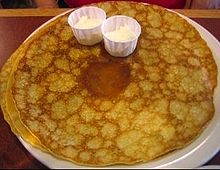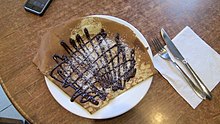Preparation
Crêpes are made by pouring a wheat batter onto a frying pan or flat circular hot plate, often with a trace of butter or vegetable oil on the pan's surface. The batter is spread evenly over the cooking surface of the pan or plate either by tilting the pan or by distributing the batter with an offset spatula or trowel.[2][3] The consistency of the batter should not be too thick, nor should the pan be too hot. In either of these instances, the crêpe could be ruined with lumpiness or tears. Cooking may take 30 to 60 seconds until the cooked side looks like the surface of the moon, then it is turned over to cook the other side; one can flip it in the air by swinging the pan.Because the outside of the crêpe is more attractive, they are typically never served inside out.[4]
Sweet crêpes are generally made with wheat flour while savory crêpes are made with non-wheat flours such as buckwheat. Batters can also consist of other simple ingredients such as butter, milk, water, eggs, flour, salt, and sugar.[5]
Common savoury fillings for crêpes served for lunch or dinner are cheese, ham, and eggs, ratatouille, mushrooms, artichoke (in certain regions), and various meat products. The fillings are commonly added to the center of the crêpe and served with the edges partially folded over the center.
When sweet, they can be eaten as part of breakfast or as a dessert. They can be filled and topped with various sweet toppings, often including Nutella spread, preserves, sugar (granulated or powdered), maple syrup, golden syrup, lemon juice, whipped cream, fruit spreads, custard, and sliced soft fruits or confiture.
Types and special crêpes

Mille crêpe
English pancakes are like wheat flour crêpes, and are served with golden syrup or lemon juice and sugar. Swedish pancakes, also called Nordic pancakes, are similar to the French crêpes. In some of the Nordic countries, they are served with jam or fruit, especially lingonberries (or the butter from that fruit) as a dessert with a variety of savory fillings. Traditional Swedish variations can be exotic. Beside the usual thin pancakes, called pannkakor in Swedish and räiskäle in Finnish, which resemble the French crêpes and, often served with whipped cream and jam, are traditionally eaten for lunch on Thursdays with pea soup, the Swedish cuisine (as well as the Finnish one) has plättar/lettu which resemble tiny English pancakes, and are fried several at a time in a special pan. Others resemble German pancakes but include fried pork in the batter (fläskpannkaka); these are baked in the oven. Potato pancakes called raggmunk contain shredded raw potato and may contain other vegetables (sometimes the pancake batter is omitted, producing rårakor). Raggmunk and rårakor are traditionally eaten with pork rinds and lingonberry jam. A special Swedish pancake is saffron pancake from Gotland, made with saffron and rice, baked in the oven. It is common to add lemon juice to the sugar for extra taste. The pancakes are often served after a soup. Another special "Swedish pancake" is the äggakaka (eggcake), also called skånsk äggakaka (scanian eggcake), it is almost like an ordinary Swedish pancake but it is a lot thicker and also a lot more difficult to make due to the risk of burning it. It is made in a frying pan and is about 1½ to 2 inches thick and is served with lingonberries and bacon. The Norwegian variety is commonly eaten for dinner, traditionally with bacon, jam (typically bilberry jam) or sugar.
A plate of 49er flapjacks
Cherry Kijafa Crêpes are also often common and are made with a traditional crêpe base, but filled with cherries simmered in a Kijafa wine sauce.[9]
Crêpe dentelle is a crispy biscuit made with a very thin layer of crêpe folded in a cigar shape and then baked. It is usually enjoyed with a hot drink during the goûter, in France.
Crêperies
A small crêperie
Crêperies are typical of Brittany in France; however, crêperies can be found throughout France and in many other countries.
Because a crêpe may be served as both a main meal or a dessert, crêperies may be quite diverse in their selection and may offer other baked goods such as baguettes. They may also serve coffee, tea, buttermilk, and cider (a popular drink to accompany crêpes).
In other countries
A sweet crêpe filled with oats, berries, and topped with whipped cream.
Frixuelos. This is a kind of crêpe made in Asturias, Spain.
In areas of central Europe, formerly belonging to the Austro-Hungarian empire, there is a thin pancake comparable to a crêpe that in Austro-Bavarian is called Palatschinken; in Hungarian: palacsinta; and in Bosnian, Serbian, Bulgarian, Macedonian, Montenegrin, Czech, Croatian, and Slovene: palačinka; in Slovak: palacinka. In the Balkan region such as the countries of Albania, Bosnia, Croatia, Kosovo, Macedonia, Montenegro, and Serbia, palačinka or pallaçinka may be eaten with fruit jam, quark cheese, sugar, honey, or the hazelnut-chocolate cream Nutella. In Ashkenazi Jewish cuisine, there is a similar dish known as the blintz. The Oxford English Dictionary derives the German and Slavic words from the Hungarians palacsinta, which it derives from the Romanian plăcintă, which comes in turn from classical Latin placenta ("small flat cake"), even though the Romanian plăcintă is more similar to a pie, and the crêpes are actually called clătită.
Crêpes have also long been popular in Japan, with sweet and savoury varieties being sold at many small stands, usually called crêperies. In Argentina and Uruguay, they are called panqueques and are often eaten with dulce de leche. Various other French foods, such as crêpes, souffles, and quiche, have slowly made their way into North American cooking establishments.[13] Typically, these franchises stick to the traditional French method of making crêpes but they have also put their own spin on the crêpe with new types such as the hamburger and pizza crêpe. In Mexico, crêpes are known as crepas, and were introduced during the 19th century by the French [14][15] and are typically served either as a sweet dessert when filled with cajeta (similar to dulce de leche), or as a savoury dish when filled with Huitlacoche (corn smut), which is considered a delicacy.
Crêpes in European culture
During Russian celebration of Maslenitsa (Russian Butter Week), one of the most popular foods is blini, or crepes. Since crepes are made from the butter, eggs and milk, they are allowed to be consumed during the celebration by the Orthodox church. There are endless combinations to the recipes and the execution of crepes. White flour can be replaced with buckwheat flour and milk can be switched for kefir. Also different oils can be added or substituted. Blini are served stocked with a piece of butter and topped with caviar, cheese, meat, potatoes, mushrooms, honey, berry jam or often a dollop of sour cream. The dish is supposed to represent the sun, since the holiday is about the beginning of the spring. [16]In addition to crêperies and crêpe franchises, there are crêpe manufacturers that use modern equipment to produce crêpes in bulk.
Chocolate-Coconut Crêpe served in crêperie near the Pantheon in Paris, France
In culture
The crepe was born as an accident, created by fourteen year old waiter Henri Carpentier in 1895 at the Maitre at Monte Carlo’s Cafde Paris. He was preparing a desert for the Prince of Wales and describes the creation of the desert in a published book about his life. He states that it was an accident that the pastry had burned and Carpentier tasted it hoping it would be good enough to serve, since there wasn’t enough time to create a new dish. Carpentier describes the creation of the crepe with, “Thus was born and baptized this confection, one taste of which, I really believe, would reform a cannibal into a civilized gentleman.” It was served to the prince who enjoyed it so much that the following day he sent it’s creator a panama hat, a cane, and a jeweled ring.In France, crêpes are traditionally served on Candlemas (La Chandeleur), 2 February. This day was originally Virgin Mary's Blessing Day but became known in France as "Le Jour des Crêpes" (literally translated "The Day of the Crêpes", but sometimes given colloquially as "Avec Crêpe Day", "National Crêpe Day", or "day of the Crêpe "), referring to the tradition of offering crêpes. The belief was that if you could catch the crêpe with a frying pan after tossing it in the air with your right hand and holding a gold coin in your left hand, you would become rich that year.[17][18] The roundness, and golden color from being fried in butter, of the crêpe resembles the sun and its rays. This symbolism also applies to the coin held in the person's hand.





Tidak ada komentar:
Posting Komentar